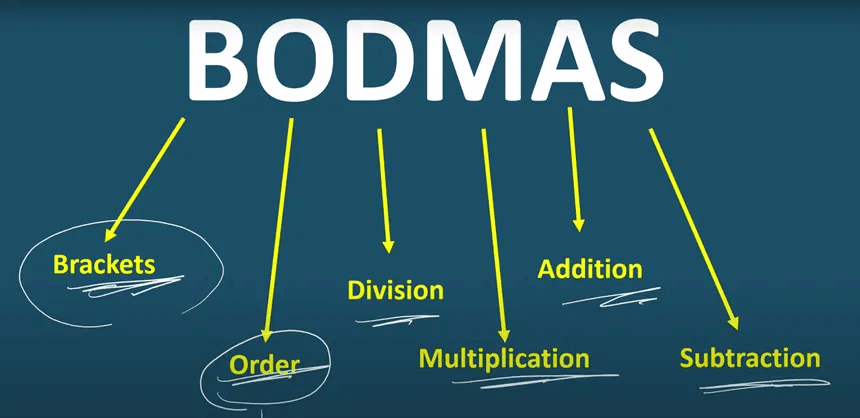Important Formulas: Simplification | General Test Preparation for CUET UG - CUET Commerce PDF Download
BODMAS Rule

The BODMAS rule dictates the order in which operations should be performed to evaluate an expression correctly. The acronym stands for:
B - Brackets (First, solve anything inside brackets: (), {}, [])
O - Of (This represents powers or exponents, e.g., 2²)
D - Division (Next, perform division)
M - Multiplication (Next, perform multiplication)
A - Addition (After multiplication/division, perform addition)
S - Subtraction (Finally, perform subtraction)
In simplification, start by solving expressions inside brackets, then move on to exponents, followed by division, multiplication, addition, and subtraction in the order listed.
Modulus of a Real Number
The modulus (or absolute value) of a real number a is defined as:
|a| = a if a > 0
|a| = -a if a < 0
For example:
|5| = 5
|-5| = 5 (since -(-5) = 5).
Vernacular (or Bar)
When an expression involves a Vernacular (often represented as a bar), simplify the expression under the Vernacular first before applying the BODMAS rule.
Roots
Roots, or radicals, are the opposite of exponents. For example, the square root of 4 is 2, as 2² = 4. The square root of 9 is 3, since 3² = 9.
- The square root is written as √.
- Cube roots are written as ∛.
- Similarly, the fourth root is ∜, and so on.
For example:
√9 = 3
∛27 = 3 (cube root of 27).
Simplifying Square Root Terms
To simplify a square root expression:
- Extract perfect squares. For example, √4 = 2, √9 = 3.
- If the argument inside the square root isn't a perfect square but can be factored, break it down into factors, and then simplify the expression.
For example:
- √18 = √(9 * 2) = √9 * √2 = 3√2.
Important Formulas for Simplification
Here is a list of important formulas that can be helpful when simplifying expressions:
1. BODMAS Rule (Order of Operations)
- Brackets: Solve operations inside brackets first ( (), {}, [])
- Orders: Apply exponents (powers) like squares, cubes, etc.
- Division and Multiplication: Solve division and multiplication from left to right.
- Addition and Subtraction: Solve addition and subtraction from left to right.
2. Percentage Calculations
Percentage Formula:
Percentage = (Part / Whole) * 100
To find the percentage of a number:
Percentage of a number = (P / 100) * X
Where P is the percentage and X is the number.Finding a Number from Percentage:
X = (Percentage * Whole) / 100
3. Average Formula
- Average:
Average = (Sum of all values) / (Number of values)
4. Simplifying Fractions
Simplifying a Fraction:
Simplified Fraction = (Numerator / Denominator) (divide both by the greatest common divisor)Multiplying Fractions:
(a / b) * (c / d) = (a * c) / (b * d)Dividing Fractions:
(a / b) ÷ (c / d) = (a / b) * (d / c) = (a * d) / (b * c)
5. Simplification of Square Roots
Square Root of a Product:
√(a * b) = √a * √bSquare Root of a Quotient:
√(a / b) = √a / √bSquare of a Number:
(a)² = a * a
6. Simplification of Cube Roots
Cube Root of a Product:
∛(a * b) = ∛a * ∛bCube Root of a Quotient:
∛(a / b) = ∛a / ∛b
7. Exponent Rules
Multiplying Powers with Same Base:
am * an = a(m + n)Dividing Powers with Same Base:
am / an = a(m + n)Power of a Power:
(am)n = a(m * n)Multiplying Powers with Different Bases but Same Exponent:
an * bn = (a * b)nNegative Exponent Rule:
a(-n) = 1 / an
8. Surds and Radicals
Simplifying Square Roots:
To simplify square roots, look for perfect squares inside the root.
Example: √18 = √(9 * 2) = √9 * √2 = 3√2Simplifying Cube Roots:
Similar to square roots, simplify cube roots by factoring out perfect cubes.
Example: ∛54 = ∛(27 * 2) = ∛27 * ∛2 = 3∛2
9. Logarithms (for advanced simplification)
- Logarithmic Properties:
logb(x * y) = logb x + logb y
logb(x / y) = logb x - logb y
logb(x^n) = n * logb x
logb b = 1 and logb 1 = 0
10. Percentage Increase and Decrease
Percentage Increase:
New Value = Original Value * (1 + (P / 100))Percentage Decrease:
New Value = Original Value * (1 - (P / 100))
11. Solving Simple Equations
Linear Equations:
For equations like ax + b = 0, solve for x:
x = -b / aQuadratic Equations:
For equations of the form ax² + bx + c = 0, use the quadratic formula:
x = (-b ± √(b² - 4ac)) / (2a)
Solved Examples for Simplification
Example 1: The price of 10 chairs is equal to that of 4 tables. The price of 15 chairs and 2 tables together is Rs. 4000. Find the total price of 12 chairs and 3 tables.
Solution: Let the cost of a chair be Rs. x and the cost of a table be Rs. y.
From the given, we know: Price of 10 chairs = Price of 4 tables → 10x = 4y This simplifies to: y = (5/2)x
We are also told that the price of 15 chairs and 2 tables is Rs. 4000: 15x + 2y = 4000
Substitute y = (5/2)x into this equation: 15x + 2 * (5/2)x = 4000 15x + 5x = 4000 20x = 4000 → x = 200
Now substitute x = 200 into y = (5/2)x: y = (5/2) * 200 = 500
The total price of 12 chairs and 3 tables is: 12x + 3y = 12 * 200 + 3 * 500 = 2400 + 1500 = 3900
Thus, the total cost is Rs. 3900.
|
164 videos|800 docs|1162 tests
|
















